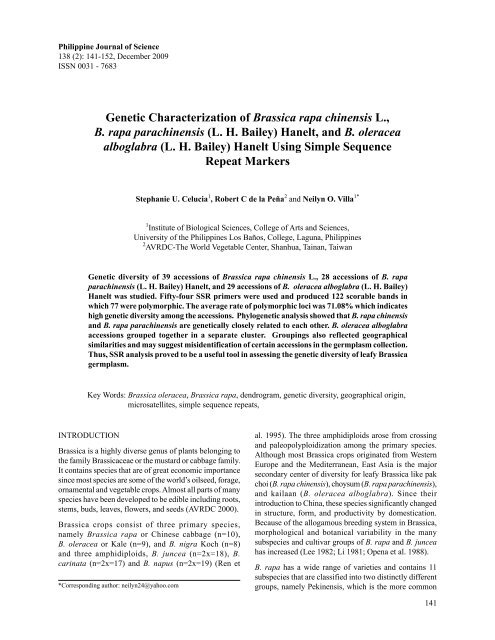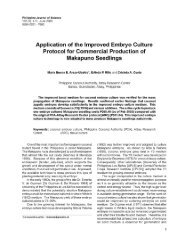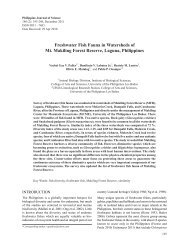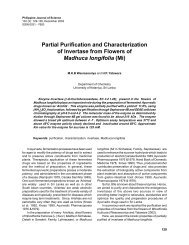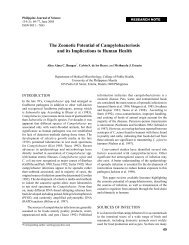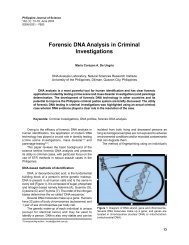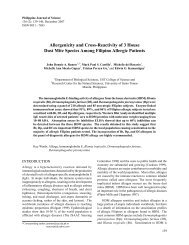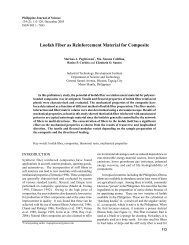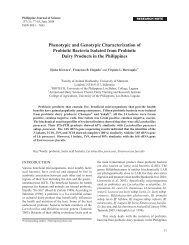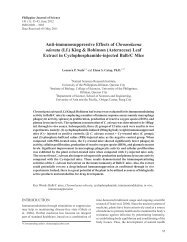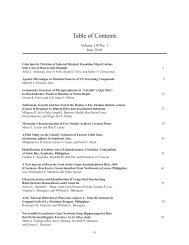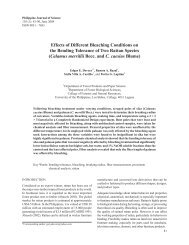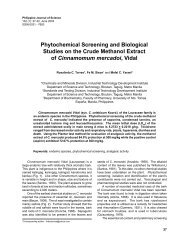Genetic Characterization of Brassica rapa chinensis L., B. rapa ...
Genetic Characterization of Brassica rapa chinensis L., B. rapa ...
Genetic Characterization of Brassica rapa chinensis L., B. rapa ...
You also want an ePaper? Increase the reach of your titles
YUMPU automatically turns print PDFs into web optimized ePapers that Google loves.
Philippine Journal <strong>of</strong> Science<br />
138 (2): 141-152, December 2009<br />
ISSN 0031 - 7683<br />
<strong>Genetic</strong> <strong>Characterization</strong> <strong>of</strong> <strong>Brassica</strong> <strong>rapa</strong> <strong>chinensis</strong> L.,<br />
B. <strong>rapa</strong> para<strong>chinensis</strong> (L. H. Bailey) Hanelt, and B. oleracea<br />
alboglabra (L. H. Bailey) Hanelt Using Simple Sequence<br />
Repeat Markers<br />
Stephanie U. Celucia 1 , Robert C de la Peña 2 and Neilyn O. Villa 1*<br />
1 Institute <strong>of</strong> Biological Sciences, College <strong>of</strong> Arts and Sciences,<br />
University <strong>of</strong> the Philippines Los Baños, College, Laguna, Philippines<br />
2 AVRDC-The World Vegetable Center, Shanhua, Tainan, Taiwan<br />
<strong>Genetic</strong> diversity <strong>of</strong> 39 accessions <strong>of</strong> <strong>Brassica</strong> <strong>rapa</strong> <strong>chinensis</strong> L., 28 accessions <strong>of</strong> B. <strong>rapa</strong><br />
para<strong>chinensis</strong> (L. H. Bailey) Hanelt, and 29 accessions <strong>of</strong> B. oleracea alboglabra (L. H. Bailey)<br />
Hanelt was studied. Fifty-four SSR primers were used and produced 122 scorable bands in<br />
which 77 were polymorphic. The average rate <strong>of</strong> polymorphic loci was 71.08% which indicates<br />
high genetic diversity among the accessions. Phylogenetic analysis showed that B. <strong>rapa</strong> <strong>chinensis</strong><br />
and B. <strong>rapa</strong> para<strong>chinensis</strong> are genetically closely related to each other. B. oleracea alboglabra<br />
accessions grouped together in a separate cluster. Groupings also reflected geographical<br />
similarities and may suggest misidentification <strong>of</strong> certain accessions in the germplasm collection.<br />
Thus, SSR analysis proved to be a useful tool in assessing the genetic diversity <strong>of</strong> leafy <strong>Brassica</strong><br />
germplasm.<br />
Key Words: <strong>Brassica</strong> oleracea, <strong>Brassica</strong> <strong>rapa</strong>, dendrogram, genetic diversity, geographical origin,<br />
microsatellites, simple sequence repeats,<br />
INTRODUCTION<br />
<strong>Brassica</strong> is a highly diverse genus <strong>of</strong> plants belonging to<br />
the family <strong>Brassica</strong>ceae or the mustard or cabbage family.<br />
It contains species that are <strong>of</strong> great economic importance<br />
since most species are some <strong>of</strong> the world’s oilseed, forage,<br />
ornamental and vegetable crops. Almost all parts <strong>of</strong> many<br />
species have been developed to be edible including roots,<br />
stems, buds, leaves, flowers, and seeds (AVRDC 2000).<br />
<strong>Brassica</strong> crops consist <strong>of</strong> three primary species,<br />
namely <strong>Brassica</strong> <strong>rapa</strong> or Chinese cabbage (n=10),<br />
B. oleracea or Kale (n=9), and B. nigra Koch (n=8)<br />
and three amphidiploids, B. juncea (n=2x=18), B.<br />
carinata (n=2x=17) and B. napus (n=2x=19) (Ren et<br />
*Corresponding author: neilyn24@yahoo.com<br />
al. 1995). The three amphidiploids arose from crossing<br />
and paleopolyploidization among the primary species.<br />
Although most <strong>Brassica</strong> crops originated from Western<br />
Europe and the Mediterranean, East Asia is the major<br />
secondary center <strong>of</strong> diversity for leafy <strong>Brassica</strong> like pak<br />
choi (B. <strong>rapa</strong> <strong>chinensis</strong>), choysum (B. <strong>rapa</strong> para<strong>chinensis</strong>),<br />
and kailaan (B. oleracea alboglabra). Since their<br />
introduction to China, these species significantly changed<br />
in structure, form, and productivity by domestication.<br />
Because <strong>of</strong> the allogamous breeding system in <strong>Brassica</strong>,<br />
morphological and botanical variability in the many<br />
subspecies and cultivar groups <strong>of</strong> B. <strong>rapa</strong> and B. juncea<br />
has increased (Lee 1982; Li 1981; Opena et al. 1988).<br />
B. <strong>rapa</strong> has a wide range <strong>of</strong> varieties and contains 11<br />
subspecies that are classified into two distinctly different<br />
groups, namely Pekinensis, which is the more common<br />
141
Philippine Journal <strong>of</strong> Science<br />
Vol. 138 No. 2, December 2009<br />
group, and Chinensis. B. r. <strong>chinensis</strong> is commonly called<br />
Pak choi. It is also called “bok choy”, in English, and<br />
“xiao baicai” ("small white vegetable") in Mandarin.<br />
Chinensis varieties do not form heads. They have smooth,<br />
dark green leaf blades forming a cluster suggestive <strong>of</strong><br />
mustard. B. <strong>rapa</strong> para<strong>chinensis</strong> is a commercial variant<br />
<strong>of</strong> B. <strong>rapa</strong> <strong>chinensis</strong>. It is a small, delicate version <strong>of</strong> bok<br />
choy or simply the flowering heart <strong>of</strong> any Chinese cabbage<br />
(Kessler 1989; Evans et al. 1988).<br />
On the other hand, the species B. oleracea contains a<br />
wide array <strong>of</strong> vegetables, including broccoli, cauliflower,<br />
and brussel sprouts. B. oleracea alboglabra is a form <strong>of</strong><br />
cabbage in which the central leaves do not form a head.<br />
It is considered to be closer to wild cabbage than most<br />
domesticated forms. Kai-lan, a separate cultivar <strong>of</strong> B.<br />
oleracea much used in Chinese cuisine, is somewhat<br />
similar to kale in appearance and is occasionally called<br />
"kale" in English (Guerena 2006; Hanson 2006; van der<br />
Vossen 1993).<br />
<strong>Genetic</strong> diversity is very important to a successful<br />
crop improvement. It helps protect our food supply by<br />
broadening the range <strong>of</strong> genes available to meet agricultural<br />
production challenges. The evaluation <strong>of</strong> genetic diversity<br />
present in germplasm collections promotes the efficient<br />
use <strong>of</strong> genetic variation in establishing a breeding program<br />
(Paterson 1991).<br />
There have been studies on identifying genetic relationships<br />
<strong>of</strong> <strong>Brassica</strong> species using different genetic markers. A<br />
study by Ren et al. (1995) used RAPD markers to assess<br />
the diversity <strong>of</strong> Chinese vegetable brassicas. It also<br />
suggested that Chinese cabbage is more likely to have<br />
been produced from the hybridization <strong>of</strong> pak choi and<br />
turnip than as a selection <strong>of</strong> pak choi and turnip alone. In<br />
another study (An et al. 2000), the genetic relationships<br />
among <strong>Brassica</strong> species based on RAPD markers were<br />
used to provide information for properly selecting<br />
parents <strong>of</strong> crosses and improving breeds <strong>of</strong> <strong>Brassica</strong><br />
species. Furthermore, Zhao et al. (2005) inferred genetic<br />
relationships within B. <strong>rapa</strong> using AFLP fingerprints.<br />
In 2004, Lowe et al. mentioned that microsatellite or SSR<br />
(simple sequence repeat) markers have been developed<br />
and characterized for use with genetic studies <strong>of</strong> <strong>Brassica</strong><br />
species. More recently, Louarn et al. (2007) used database<br />
derived SSR markers for cultivar differentiation in B.<br />
oleracea. SSRs are tandem repeat sequences having less<br />
than six base pairs. They are very polymorphic due to the<br />
high mutation rate affecting the number <strong>of</strong> repeat units.<br />
They are also very abundant and randomly distributed in<br />
the genome. Polymorphisms <strong>of</strong> SSR can be easily detected<br />
on high-resolution gels (Gianfranceschi 1998). SSR is<br />
advantageous over other DNA-based markers because it<br />
Villa et al.: <strong>Genetic</strong> <strong>Characterization</strong> <strong>of</strong> Leafy <strong>Brassica</strong><br />
Species Using SSR Markers<br />
is co-dominant, evenly distributed in the genome, and it<br />
allows the identification <strong>of</strong> many alleles at a single locus.<br />
It also requires only a small amount <strong>of</strong> DNA for PCR<br />
(polymerase chain reaction) analysis.<br />
In this investigation, SSR markers were used to assess the<br />
relationships among economically important leafy <strong>Brassica</strong><br />
species, namely B. <strong>rapa</strong> <strong>chinensis</strong>, B. <strong>rapa</strong> para<strong>chinensis</strong><br />
and B. oleracea alboglabra. Since the genetic diversity <strong>of</strong><br />
leafy <strong>Brassica</strong> is not well characterized, this study would<br />
be able to benefit researchers from around the world who<br />
work with these species.<br />
MATERIALS AND METHODS<br />
Plant materials. This study included 39 accessions<br />
<strong>of</strong> B. <strong>rapa</strong> <strong>chinensis</strong> (Figure 1a), 28 accessions <strong>of</strong> B.<br />
<strong>rapa</strong> para<strong>chinensis</strong> (Figure 1b), and 29 accessions <strong>of</strong> B.<br />
oleracea alboglabra (Figure 1c). The accessions were<br />
obtained from the germplasm collection <strong>of</strong> the <strong>Genetic</strong><br />
Resources and Seed Unit (GRSU) <strong>of</strong> the Asian Vegetable<br />
Research and Development Center (AVRDC) in Shanhua,<br />
Taiwan. The collection includes conventional and modern<br />
cultivars originating from different geographical locations.<br />
The accessions used in the study are listed in Table 1.<br />
Seeds were sown in a soil bed 10 cm apart within a row<br />
and 15 cm between rows on the bed. One four-row plot<br />
was made in 1m-soil bed. There were 3 replications for<br />
every accession.<br />
Primers. Fifty-four simple sequence primer pairs were<br />
used to generate the DNA fingerprints. Their name, motif<br />
type, forward, and reverse primers are listed in Table 2.<br />
Primers 1-13 and 51 were designed based on their location<br />
in the genetic map <strong>of</strong> B. napus; primers 14, 15 and 52<br />
were found on a B. nigra genetic map; primers 16-35, 53<br />
and, 54 were located in B. oleracea; and primers 36-50,<br />
55, and 56 were located in the genetic map <strong>of</strong> B. <strong>rapa</strong>.<br />
The primers used in this study are developed by Lowe<br />
et. al. in 2004.<br />
Genomic DNA extraction. Three months after sowing,<br />
the youngest healthy leaves were harvested from 10 plants<br />
<strong>of</strong> each accession. They were placed in small, transparent,<br />
resealable plastic bags and were immediately placed in<br />
-80°C freezer until use.<br />
Leaves were frozen individually by dipping into liquid<br />
nitrogen and were ground using mortar and pestle. The<br />
powdered sample was collected in a 1.5 mL plastic<br />
tube with cap and kept in -20°C refrigerator while the<br />
extraction buffer (Echevarria-Machado et al. 2005) was<br />
being prepared.<br />
142
Philippine Journal <strong>of</strong> Science<br />
Vol. 138 No. 2, December 2009<br />
Villa et al.: <strong>Genetic</strong> <strong>Characterization</strong> <strong>of</strong> Leafy <strong>Brassica</strong><br />
Species Using SSR Markers<br />
Figure 1. The three <strong>Brassica</strong> species used in this study (a) B. <strong>rapa</strong> <strong>chinensis</strong>, (b) B. <strong>rapa</strong> para<strong>chinensis</strong> and (c) B. oleracea<br />
alboglabra.<br />
Table 1. List <strong>of</strong> accessions used in this study, their variety names, and geographical origins.<br />
Accession Number Variety name Subspecies Geographical Origin<br />
<strong>Brassica</strong> <strong>rapa</strong><br />
CR001 Zhu Pob Tsai <strong>chinensis</strong> Guangzhou / China<br />
CR004 Xia Hua (F1) <strong>chinensis</strong> Clover Seeds / Hong Kong<br />
CR009 Lvxiu91-1 <strong>chinensis</strong> Qingdao / China<br />
CR011 Hangzhou Long-Petioled <strong>chinensis</strong> Hangzhou / China<br />
CR012 Hangzhou Shiny Winter <strong>chinensis</strong> Hangzhou / China<br />
CR013 Suzhou Green <strong>chinensis</strong> Hangzhou / China<br />
CR014 Shanghai May Late <strong>chinensis</strong> Hangzhou / China<br />
CR015 Shanghai April Late <strong>chinensis</strong> Hangzhou / China<br />
CR017 Black-Leaved May Late <strong>chinensis</strong> Shanghai / China<br />
CR019 Bottle Long-Petioled White <strong>chinensis</strong> Zhejiang / China<br />
CR020 Black Shiny Winter <strong>chinensis</strong> Zhejiang / China<br />
CR021 Savoy Pakchoi <strong>chinensis</strong> Zhejiang / China<br />
CR022 Thailand Fast <strong>chinensis</strong> Jiansu / China<br />
CR027 Clover Pakchoi (128) <strong>chinensis</strong> Clover Seeds / Hong Kong<br />
CR030 Shen-Bao Green No.2 <strong>chinensis</strong> Shanghai / China<br />
CR031 Heat Resistant 605 Green <strong>chinensis</strong> Shanghai / China<br />
CR034 Long-Petioled White <strong>chinensis</strong> Hangzhou / China<br />
CR039 Qing You Si Hao <strong>chinensis</strong> Jiansu / China<br />
CR040 Fu-Bao Heat Resistant Green <strong>chinensis</strong> Jiansu / China<br />
CR041 Aijiao Datou Qingjiang Pakchoi <strong>chinensis</strong> Fujian / China<br />
CR044 Dwarf Black Behay <strong>chinensis</strong> Guangzhou / China<br />
CR048 Four Season Sweet Pakchoi <strong>chinensis</strong> Guangdong / China<br />
CR049 Golden Early No.1 Sweet Pakchoi <strong>chinensis</strong> Guangdong / China<br />
CR050 Yellow Leaved Pakchoi <strong>chinensis</strong> Guangzhou / China<br />
CR051 Dwarf Pakchoi <strong>chinensis</strong> Guangzhou / China<br />
CR052 Late Dwarf Black-Leaved <strong>chinensis</strong> Guangzhou / China<br />
CR068 Czuen-Shuei Pakchoi <strong>chinensis</strong> Guangzhou / China<br />
CR070 Hongkong Dwarf Milky White <strong>chinensis</strong> Good Earth Seeds / Hong Kong<br />
CR075 Yellow Leaf (Local Variety) <strong>chinensis</strong> Vegetable and Fruit Seeds / Vietnam<br />
table continued next page . . .<br />
143
Philippine Journal <strong>of</strong> Science<br />
Vol. 138 No. 2, December 2009<br />
Villa et al.: <strong>Genetic</strong> <strong>Characterization</strong> <strong>of</strong> Leafy <strong>Brassica</strong><br />
Species Using SSR Markers<br />
table 1 continuation<br />
Accession Number Variety name Subspecies Geographical Origin<br />
CR076 Yellow Stem (Local Variety) <strong>chinensis</strong> Local Variety / Vietnam<br />
CR077 Green Stem (Local Variety) <strong>chinensis</strong> Local Variety / Vietnam<br />
CR079 Selected Spoon Pakchoi <strong>chinensis</strong> Shantong / China<br />
CR091 Dwarf Erect Pakchoi <strong>chinensis</strong> Guangzhou / China<br />
CR092 Early Huang-Jing Pakchoi <strong>chinensis</strong> Guangdong / China<br />
CR094 Pakchoy White <strong>chinensis</strong> Tropica Vegetable Seeds / Vietnam<br />
Bcc11 KSL Nylon Pakchoi <strong>chinensis</strong> KSL / Taiwan<br />
Bcc19 WYS Huang-Jing Pakchoi <strong>chinensis</strong> WYS / Taiwan<br />
Bp05 (KY0606)Ching Chiang Pai-Tsai <strong>chinensis</strong> Known-You Seeds / Taiwan<br />
Bp07 (KY0603)Gracious Pai-Tsai <strong>chinensis</strong> Known-You Seeds / Taiwan<br />
CR003 Early White (IV) (F1) para<strong>chinensis</strong> Hunan / China<br />
CR005 Shiny Green No.12 para<strong>chinensis</strong> Guangzhou / China<br />
CR006 No.49-19 Choysum para<strong>chinensis</strong> Guangzhou / China<br />
CR007 Liu Bao 701 para<strong>chinensis</strong> Guangzhou / China<br />
CR010 Giant Seeds’ Choysum(A-12) para<strong>chinensis</strong> Guangzhou / China<br />
CR023 Gai Liang Shi Yue Hong para<strong>chinensis</strong> Wuhan / China<br />
CR024 Red Hybrid 60 (F1) para<strong>chinensis</strong> Wuhan / China<br />
CR025 Early White Choysum (II) (F1) para<strong>chinensis</strong> Hunan / China<br />
CR026 Early White Choysum (III) (F1) para<strong>chinensis</strong> Hunan / China<br />
CR035 Guang-Yan #31 Shiny Green para<strong>chinensis</strong> Guangzhou / China<br />
CR037 Hsin-Liu Waxy Choysum para<strong>chinensis</strong> Shanghai / China<br />
CR042 Autumn Red No.2 para<strong>chinensis</strong> Sichuan / China<br />
CR058 Early Hybrid White Choysum para<strong>chinensis</strong> Guangzhou / China<br />
CR071 Hua-Tsuei Choysum para<strong>chinensis</strong> Beijing / China<br />
CR073 Giong Cai Ngot Tosakan para<strong>chinensis</strong> East West Seeds / Vietnam<br />
CR082 Shiny Green 60 Days para<strong>chinensis</strong> Guangzhou / China<br />
CR083 Late #2 Choysum para<strong>chinensis</strong> Guangzhou / China<br />
CR085 Cui Qing No. 26 para<strong>chinensis</strong> Guangdong / China<br />
CR087 Zao Shu Cu Tiao You Qing Tian Cai Xin para<strong>chinensis</strong> Guangzhou / China<br />
Bc07 (KY0605)Yu-Tsai-Sum para<strong>chinensis</strong> Known-You Seeds / Taiwan<br />
Bc57 Late Shiny Green #8 para<strong>chinensis</strong> Guangzhou / China<br />
B00468 Yayoi Komatsuna para<strong>chinensis</strong> Kyowa Noen / Japan<br />
B00469 Uzuki Komatsuna para<strong>chinensis</strong> Kyowa Noen / Japan<br />
B00472 Natsudora Komatsuna para<strong>chinensis</strong> Yamato Noen / Japan<br />
B00473 Fukuha Komatsuna para<strong>chinensis</strong> Yamato Noen / Japan<br />
B00474 Maruba Wase Komatsuna para<strong>chinensis</strong> Yamato Noen / Japan<br />
B00475 Goseki Komatsuna para<strong>chinensis</strong> Yamato Noen / Japan<br />
B00590 I. B. – 1737 para<strong>chinensis</strong> IARI / India<br />
B. oleracea<br />
CR046 Guang-Dong Large-Stemmed Jie Lan alboglabra Guangzhou / China<br />
CR059 Fast Grow All Season alboglabra Guangzhou / China<br />
CR060 Early Point-Leaved Kailaan alboglabra Guangzhou / China<br />
CR061 Moderate-Flowered Kailaan alboglabra Guangzhou / China<br />
CR097 (KY1314)Veg-Gin(F1) alboglabra Known-You Seeds / Taiwan<br />
table continued next page . . .<br />
144
Philippine Journal <strong>of</strong> Science<br />
Vol. 138 No. 2, December 2009<br />
Villa et al.: <strong>Genetic</strong> <strong>Characterization</strong> <strong>of</strong> Leafy <strong>Brassica</strong><br />
Species Using SSR Markers<br />
table 1 continuation<br />
Accession Number Variety name Subspecies Geographical Origin<br />
CR098 Nova alboglabra P.T. East West Seed / Indonesia<br />
Ba04 GN Black-leaf Kailaan alboglabra Kung Nong Seeds / Taiwan<br />
Ba05 GN White-leaf Kailaan alboglabra Kung Nong Seeds / Taiwan<br />
Ba08 DG Green Kailaan alboglabra Cheng Chi Seeds / Taiwan<br />
Ba09 DG Yellow Kailaan alboglabra Cheng Chi Seeds / Taiwan<br />
Ba11 EX Savoy Black Kailaan alboglabra Excellent Seeds / Taiwan<br />
Ba17 FT Savoy-leaf Black Kailaan alboglabra Fong Tien Seeds / Taiwan<br />
Ba18 Kailaan L1 (Chrysanthemum) alboglabra FTHES / Taiwan<br />
Ba19 Kailaan L2 (Round-leaf) alboglabra FTHES / Taiwan<br />
Ba20 Kailaan L3 (Big-flower) alboglabra FTHES / Taiwan<br />
Ba24 Round-leaf Black Kailaan alboglabra Excellent Seeds / Taiwan<br />
Ba25 High-stem Round-leaf Kailaan alboglabra Nien Fong Seeds / Taiwan<br />
Ba27 Kailaan (White-flower) alboglabra Nien Fong Seeds / Taiwan<br />
Ba32 Stem Kailaan BBT 35 alboglabra East-West Seed / Philippines<br />
Ba33 Kailaan alboglabra Ramgo Seeds / Philippines<br />
Ba34 Chinese Kale: Khana Yot alboglabra Chia Tai Seeds / Thailand<br />
Ba35 Large Leaf Kailaan alboglabra Chia Tai Seeds / Thailand<br />
Ba38 Yellow-Flower White Kailaan alboglabra Fu Nong Seeds / Taiwan<br />
Ba39 Savoy-Leaf Kailaan 117 alboglabra Leckat Co. / Malaysia<br />
Ba41 Yellow-Flower Large-Stem Kailaan alboglabra Fong Tien Seeds / Taiwan<br />
TB00216 Taoyuan #3 (B01127) alboglabra Taoyuan DAIS / Taiwan<br />
TB00217 Taoyuan #4 (B01128) alboglabra Taoyuan DAIS / Taiwan<br />
TB00799 Mbeya Green A alboglabra RCA / Tanzania<br />
TB00800 Mbeya Green B alboglabra RCA / Tanzania<br />
Table 2. Summary <strong>of</strong> simple sequence repeat primer pairs used in the genetic characterization <strong>of</strong> <strong>Brassica</strong>.<br />
Primer<br />
Count<br />
Primer<br />
Name<br />
Motif Type Forward Primer Reverse Primer<br />
1 Na10-E02 di GA/CT TCGCGCATGTAATCAAAATC TGTGACGCATCCGATCATAC<br />
2 Na10-F06 tri GGC/CCG CTCTTCGGTCGATCCTCG TTTTTAACAGGAACGGTGGC<br />
3 Na12-C03 di GA/CT ATCGTTGCCATTAGGAGTGG ACCAAATTAACCCTCTTTGC<br />
4 Na12-C06 di GA/CT AACGGATGAAGAACACATTGC TAGGGCCTGTTATTCGATGG<br />
5 Na12-C07 di GA/CT ACTCAACCCCACAAACCTG AGTTCCCCGGACCGATTAG<br />
6 Na12-C08 di GA/CT GCAAACGATTTGTTTACCCG CGTGTAGGGTGATCTATGATGGG<br />
7 Na12-D03 di GA/CT GGTAAGCCAAAAACCCTTCC GAAACCGGTAACAAAGTCGG<br />
8 Na12-F12 tri GGC/CCG CGTTCTCACCTCCGATAAGC TCCGATGTAGAATCAGCAGC<br />
9 Na14-B03 di GA/CT GATGGTGCCGATTCAATGA CCCATCAGCACTAGAAACCA<br />
10 Na14-C12 di GA/CT CACATTTTGGTTCAATTCGG TACGACCTGGTTTCGATTC<br />
11 Na14-D07 tri GGC/CCG GCATAACGTCAGCGTCAAAC CTGCGGGACACATAACTTTG<br />
12 Na14-E02 com GA/CT-GT/CA ACTGGCTACATGAGTTTCAGTG GAGGGAAGACAACTGGTCTCA<br />
13 Na14-E08 tri GGC/CCG TTACTATCCCCTCTCCGCAC GCGGATTATGATGACGCAG<br />
14 Ni2-B01 dis di GT/CA AAGGAGATTGTTTTGGGGC AAGACTAATAAACACACGGCG<br />
15 Ni4-E08 di GA/CT GATTTTGAGGAAGCGGAGG CAAAGCACTGAGAGAGAGAGAGAG<br />
table continued next page . . .<br />
145
Philippine Journal <strong>of</strong> Science<br />
Vol. 138 No. 2, December 2009<br />
Villa et al.: <strong>Genetic</strong> <strong>Characterization</strong> <strong>of</strong> Leafy <strong>Brassica</strong><br />
Species Using SSR Markers<br />
table 2 continuation<br />
Primer<br />
Count<br />
Primer<br />
Name<br />
Motif Type Forward Primer Reverse Primer<br />
16 Ol10-A05 di GA/CT TGTAATAACCCGACCCATCC CTCTCTCGCTCTCTCGATCC<br />
17 Ol10-B01 di GA/CT CCTCTTCAGTCGAGGTCTGG AATTTGGAAACAGAGTCGCC<br />
18 Ol10-F11 tri GGC/CCG TTTGGACGTCCGTAGAAGG CAGCTGACTTCGAAAGGTCC<br />
19 Ol10-G08 di GA/CT TGCTTAATTGATTAGGGCAG TTACCTCATCAGGTGGAGGC<br />
20 Ol10-G09 di GA/CT TGCTTCCTTTTCTTCGCTC GAAGCACGAACGCGAGAG<br />
21 Ol10-H04 di GA/CT TCACCCCTCTATATCCACCC CAGAATCTGCCTGAACATCG<br />
22 Ol10-H07 di GA/CT TAGAGATGTCACCCGAAGGC AGCTTCATTTCAGTCGGTGG<br />
23 Ol11-B03 tri GGC/CCG ATGAAAACCAATCCAGTGCC GATAGCAGATGGAAGAGCCG<br />
24 Ol11-B05 di GA/CT TCGCGACGTTGTTTTGTTC ACCATCTTCCTCGACCCTG<br />
25 Ol11-G11 tri GGC/CCG GTTGCGGGCGAAACAGAGAAG GAGTAGGCGATCAAACCGAG<br />
26 Ol11-H02 tri AAT/AAG TCTTCAGGGTTTCCAACGAC AGGCTCCTTCATTTGATCCC<br />
27 Ol11-H06 di GA/CT TCCGAACACTCTAAGTTAGCTCC TTCTTCACTTCACAGGCACG<br />
28 Ol12-B05 di GA/CT GGAAAGCGAAGAGTGACGAC ATTGGGTAAAGCTGTGCTCG<br />
29 Ol12-E03 tri GGC/CCG CTTGAAGAGCTTCCGACACC GACGGCTAACAGTGGTGGAC<br />
30 Ol12-F02 di GA/CT GGCCCATTGATATGGAGATG CATTTCTCAATGATGAATAGT<br />
31 Ol12-F11 di GT/CA AAGGACTCATCGTGCAATCC GTGTCAGTGGCTACAGAGAC<br />
32 Ol12-G04 di GA/CT CGAACATCTTAGGCCGAATC GGTTAACCTGCGGGATATTG<br />
33 Ol13-C03 di GA/CT GATCGGAGATGCGATGAGAG GACTGCACCAGTGAAAAACTC<br />
34 Ol13-C12 di GA/CT AGAGGCCAACAAAGAACACC GAAGCAGCACCAGTGACAAG<br />
35 Ol13-E08 di GA/CT TTCGCAACTCCTCCTAGAATC AAGGTCTCACCACCGGAGTC<br />
36 Ra2-A01 di GA/CT TTCAAAGGAAAGGGCATCG TCTTCTTCTTTTGTTGTCTTCCG<br />
37 Ra2-A04 di GA/CT AAAAACTCCTCTCAACG CCCAAAGTTAGGTTTTAATGTAATCTC<br />
38 Ra2-A11 di GA/CT GACCTATTTTAATATGCTGTTTTACG ACCTCACCGGAGAGAAATCC<br />
39 Ra2-E01 di GT/CA TCTATATTAACGCGCGACGG GCACACACACACTCAAACCC<br />
40 Ra2-E03 di GA/CT AGGTAGGCCCATCTCTCTCC CCAAAACTTGCTCAAAACCC<br />
41 Ra2-E04 di GA/CT ACACACAACAAACAGCTCGC AACATCAAACCTCTCGACGG<br />
42 Ra2-E07 di GA/CT ATTGCTGAGATTGGCTCAGG CCTACACTTGCGATCTTCACC<br />
43 Ra2-E11 di GA/CT GGAGCCAGGAGAGAAGAAGG CCCAAAACTTCCAAGAAAAGC<br />
44 Ra2-E12 di GA/CT TGTCAGTGTGTCCACTTCGA AAGAGAAACCCAATAAAGTAGAACC<br />
45 Ra2-F11 di GA/CT TGAAACTAGGGTTTCCAGCC CTTCACCATGGTTTTGTCCC<br />
46 Ra2-G09 di GA/CT ACAGCAAGGATGTGTTGACG GAGAGCCTCTGGTTCAAGC<br />
47 Ra3-C04 tri GGC/CCG CTAACCTCAGACGGAGACGG CTTTAAACTCCGACCAACCG<br />
48 Ra3-D02B di GA/CT CACAGGAAACCGTGGCTAGA AACCCAACCTCAACGTCTTG<br />
49 Ra3-E05 di GT/CA TTCTCATGCTCCAACCACAG GTTTCTTCCAAGCCAAGGCTG<br />
50 Ra3-H10 di GA/CT TAATCGCGATCTGGATTCAC ATCAGAACAGCGACGAGGTC<br />
51 Na12-H04 di GA/CT TTTATCGTCTTTCCCCTCCC ACAAGGAACTAGAGAGAGAGAG<br />
52 Ni4-B10 di GA/CT GTCCTTGAGAAACTCCACCG CCGATCCCATTCTAATCCC<br />
53 Ol11-C02 di GT/CA GCATTGCAATCTTGTTGGTC CGTTTCCATACAGACGTAAGAC<br />
54 Ol12-D05 di GA/CT TCCATGCCAACGACAAGGTC AAGAGGCGACTCTATTGCG<br />
55 Ra2-A10 di GT/CA CCAGTGTGTGTGTGTGTGTG TTTAACAGATAGCGCAGTGGTC<br />
56 Ra2-D04 di GT/CA TGGATTCTCTTTACACACGCC CAAACCAAAATGTGTGAAGCC<br />
146
Philippine Journal <strong>of</strong> Science<br />
Vol. 138 No. 2, December 2009<br />
Wet, powdery leaf material measuring 2.5 mL was then<br />
homogenized with 1 mL extraction buffer using a standard<br />
mini vortex and transferred to a 5 ml tube. 0.25 ml <strong>of</strong> 20%<br />
SDS was added. After mixing, the tube was incubated at<br />
65°C for 10 min. An amount <strong>of</strong> 1.25 mL 5 M potassium<br />
acetate was added. The tube was shaken vigorously and<br />
incubated for 20 min on ice. Tubes were centrifuged at<br />
4500 rpm for 20 min. The supernatant was transferred<br />
to new 5 mL tubes and 3.5 mL cold isopropanol was<br />
added. The tubes were mixed manually by inverting<br />
the tubes gently for three to five minutes. Tubes were<br />
then centrifuged at 4500 rpm for 30 s. Supernatant was<br />
discarded. The pellet was washed twice or thrice with<br />
70% ethanol and was left to air dry. The pellet was then<br />
resuspended in 50 μL <strong>of</strong> sterile distilled water, incubated<br />
at 55°C for 5 min and spun at 4500 rpm for 2 min. The<br />
solution was transferred to a new 500 μL eppendorf tube.<br />
An aliquot was used for quantification <strong>of</strong> DNA in gel<br />
electrophoresis in 1.2% agarose. Four concentrations <strong>of</strong><br />
lamda DNA (200, 100, 50, and 25 ng/µL) were used to<br />
quantify the DNA. All DNA samples were diluted 30x<br />
from the original concentration to be 10 ng/µL before use<br />
as template DNA in the PCR analysis.<br />
SSR assay. Following an initial screening <strong>of</strong> 56 primers,<br />
only 54 primers were selected for use in amplification<br />
since the two other primers did not show any amplified<br />
DNA. Reaction mixtures <strong>of</strong> 15 µL contained 6.3 µL MQ<br />
H 2<br />
O, 1.5 µL 10x PCR buffer, 1.35 µL 2.5 nM dNTP, 0.375<br />
µL each <strong>of</strong> forward and reverse primers, 0.1 µL <strong>of</strong> 0.5<br />
U/µL Taq polymerase that was originally 5 U/µL, and 5<br />
µLDNA sample. Reaction mixtures were incubated in MJ<br />
Research PTC-200 Peltier Thermal Cycler DNA Engine<br />
programmed for 34 cycles <strong>of</strong> 30 s in 94°C (denaturation),<br />
1 min in 45°C (annealing temperature), and 45 s at 72°C<br />
(extension). The same reaction mixture without genomic<br />
DNA was run with each amplification to serve as negative<br />
control. Amplified products were resolved by high<br />
resolution gel electrophoresis using 4% acrylamide gel<br />
made with 1x TBE. Each piece <strong>of</strong> gel contains all samples<br />
with the same primer. Acrylamide gels were ran using a<br />
dual double-wide mini-vertical gel kit. Each gel was run<br />
at 50 volts at approximately 48 min depending on the size<br />
<strong>of</strong> PCR product. A total <strong>of</strong> 56 acrylamide gels were run<br />
corresponding to 56 primers used for the study. Using<br />
1-kb DNA ladder, band sizes <strong>of</strong> amplification products<br />
were estimated. Gels were submerged in a solution<br />
containing 10,000X Invitrogen SyBr Safe DNA gel stain<br />
for 20 min with continuous shaking and photographed<br />
under UV light.<br />
Data Analysis. SSR acrylamide gel images were scored<br />
visually. Clearly distinguishable bands were scored as<br />
present (1) or absent (0). Weak and poor bands were not<br />
Villa et al.: <strong>Genetic</strong> <strong>Characterization</strong> <strong>of</strong> Leafy <strong>Brassica</strong><br />
Species Using SSR Markers<br />
recorded. The rate <strong>of</strong> polymorphic loci was computed by<br />
dividing the number <strong>of</strong> polymorphic bands with the total<br />
number <strong>of</strong> amplified bands. The UPGMA method and<br />
Proc Cluster <strong>of</strong> SAS system was used to compute for the<br />
distance values and to generate the phylogenetic tree.<br />
Bootstrap values were not obtained.<br />
RESULTS AND DISCUSSION<br />
A total <strong>of</strong> 122 distinct bands were generated using the 54<br />
primers. From these, 77 were polymorphic. An average <strong>of</strong><br />
six polymorphic bands per primer was observed. Having<br />
generated the top polymorphic rates, twelve primers<br />
were found to be most useful for the analysis. It can be<br />
observed from Table 3 that these primers produced diverse<br />
numbers <strong>of</strong> amplified and polymorphic bands. Na11-C12<br />
produced the least number <strong>of</strong> amplified bands (with only<br />
three bands) while Ra2-E11 produced the greatest number<br />
<strong>of</strong> amplified bands (22 bands). Na10-E02 and Na11-C12<br />
produced the least number <strong>of</strong> polymorphic bands (three<br />
bands) while Ol11-G11 and Ra2-E03 produced the<br />
greatest number <strong>of</strong> polymorphic bands (10 bands). The<br />
same table also indicates the percent polymorphic loci<br />
<strong>of</strong> the 12 primers. The percentage ranged from 30% -<br />
100%, with a mean <strong>of</strong> 71.08%. Na10-E02 showed the<br />
lowest rate <strong>of</strong> polymorphic loci (30%) while Na12-C08,<br />
Na14-C12, Ol12-E03, Ol12-F11, and Ra2-E03 showed<br />
a very high polymorphic rate <strong>of</strong> 100%. This supports<br />
Table 3. Average rate <strong>of</strong> polymorphic loci <strong>of</strong> accessions <strong>of</strong> <strong>Brassica</strong> sp.<br />
using 12 different primers.<br />
PRIMER<br />
No. <strong>of</strong><br />
Amplified<br />
Bands<br />
No. <strong>of</strong><br />
Polymorphic<br />
Bands<br />
Rate <strong>of</strong><br />
Polymorphic<br />
Loci (%)*<br />
1 Na10-E02 10 3 30<br />
6 Na12-C08 4 4 100<br />
10 Na14-C12 3 3 100<br />
25 Ol11-G11 15 10 67<br />
26 Ol11-H02 10 7 70<br />
29 Ol12-E03 8 8 100<br />
30 Ol12-F02 11 6 55<br />
31 Ol12-F11 8 8 100<br />
34 Ol13-C12 11 5 45<br />
40 Ra2-E03 10 10 100<br />
43 Ra2-E11 22 8 36<br />
56 Ra2-D04 10 5 50<br />
TOTAL 122 77<br />
AVERAGE 10.17 6.42 71.08<br />
Number __________________________<br />
<strong>of</strong> polymorphic bands<br />
* Rate <strong>of</strong> Polymorphic Loci =<br />
Number <strong>of</strong> amplified bands<br />
X 100<br />
147
Philippine Journal <strong>of</strong> Science<br />
Vol. 138 No. 2, December 2009<br />
previous reports by Agrama and Tuinstra (2003), Smith<br />
et al. (1997), and Powell et al. (1996) that SSR markers<br />
are highly polymorphic. This information is important<br />
especially for future studies to distinguish which primers<br />
are appropriate for assessing genetic diversity and<br />
relationships among accessions in a germplasm collection.<br />
In this study, primers Na12-C08, Na14-C12, Ol12-E03,<br />
Ol12-F11, and Ra2-E03 are the most recommended for<br />
such purposes because they were able to demonstrate the<br />
highest polymorphism.<br />
The representative gel in Figure 2 shows bands amplified<br />
using primer Ra2-D04. Banding pattern in B. <strong>rapa</strong><br />
<strong>chinensis</strong> and B. r. para<strong>chinensis</strong> were more similar than<br />
those <strong>of</strong> B. o. alboglabra (Figure 2). B. o. alboglabra<br />
accessions gave more distinctive SSR banding patterns.<br />
This is expected because the two subspecies <strong>chinensis</strong><br />
and para<strong>chinensis</strong> are members <strong>of</strong> the same species.<br />
Moreover, B. <strong>rapa</strong> ((n=10) and B. oleracea (n=9)<br />
contain very different genomes, namely the C and the A<br />
genome, respectively. Both are believed to be two <strong>of</strong> the<br />
three ancestral genomes (the third being the B genome<br />
<strong>of</strong> B. nigra) from which the amphidiploid species B.<br />
carinata (BC genome, n=17), B. juncea (AB genome,<br />
n=18) and B. napus (AC genome, n=19) arose through<br />
paleopolyploidization (U 1935).<br />
It is also noticeable that three accessions <strong>of</strong> B. r. <strong>chinensis</strong><br />
(CR048, CR049, and CR050) and three accessions <strong>of</strong> B.<br />
r. para<strong>chinensis</strong> (CR024, CR025, and CR026) showed<br />
banding patterns that were very similar with that <strong>of</strong> five<br />
accessions <strong>of</strong> B. o. alboglabra (CR061, CR097, TB00217,<br />
TB00799, and TB00800). These B. o. alboglabra<br />
accessions exhibited banding patterns that were different<br />
from the rest <strong>of</strong> the subspecies and are more different<br />
from B. r. <strong>chinensis</strong> and B. r. para<strong>chinensis</strong> at a distance<br />
<strong>of</strong> 5.5. This was consistently observed using other primers.<br />
This observation may support the close evolutionary<br />
relationship between B. <strong>rapa</strong> and B. oleracea as reported<br />
by Chyi et al. (1992). However, it is also possible that<br />
these accessions <strong>of</strong> B. oleracea have been misidentified<br />
and are really members <strong>of</strong> B. <strong>rapa</strong>. Further analysis should<br />
be done to clarify the identity <strong>of</strong> these accessions.<br />
According to the consensus tree in Figure 3, accessions<br />
belonging to B. o. alboglabra clustered together while<br />
those belonging to B. r. <strong>chinensis</strong> and B. r. para<strong>chinensis</strong><br />
formed another cluster. Meanwhile, all varieties <strong>of</strong> B.<br />
o. alboglabra belong to cluster 1. No accessions from<br />
other subspecies clustered with B. o. alboglabra. The<br />
observation in the band patterns <strong>of</strong> B. o. alboglabra<br />
accessions CR061, CR097, TB00217, TB00799, and<br />
TB00800 can also be confirmed in the consensus<br />
dendrogram since these accessions are highly different<br />
Villa et al.: <strong>Genetic</strong> <strong>Characterization</strong> <strong>of</strong> Leafy <strong>Brassica</strong><br />
Species Using SSR Markers<br />
compared with other accessions <strong>of</strong> B. o. alboglabra. It<br />
can be observed that B. o. alboglabra accessions TB00799<br />
and TB00800 are very closely related to each other having<br />
a genetic distance <strong>of</strong> 1.0, which is the closest distance<br />
in the dendrogram. Both <strong>of</strong> these accessions came from<br />
Tanzania, which is far from the Asian origin <strong>of</strong> the other<br />
accessions used in the study.<br />
Accessions <strong>of</strong> B. r. <strong>chinensis</strong> and B. r. para<strong>chinensis</strong><br />
grouped together in Cluster 2. This is expected because<br />
they belong to the same species. Within this cluster, two<br />
subclusters were formed. In subcluster 1, B. r. <strong>chinensis</strong><br />
accessions CR048, CR049, and CR050 clustered with B. r.<br />
para<strong>chinensis</strong> accessions CR024, CR025, and CR025. All<br />
these accessions came from China. Also, these accessions<br />
showed similar banding patterns in most <strong>of</strong> the gels which<br />
were produced using different primers. It can be confirmed<br />
that these accessions are really closely related.<br />
In subcluster 2, many smaller subclusters were formed. It<br />
was evident that B. r. para<strong>chinensis</strong> accessions B00468,<br />
B00472, B00473, B00474, and B00475 clustered together.<br />
The most possible reason for this result is that these<br />
accessions all came from Japan. Out <strong>of</strong> the six accessions<br />
that came from Japan, only accession B00469 did not<br />
cluster with the other accessions. This accession clustered<br />
together with the B. r. <strong>chinensis</strong> accessions and not with<br />
B. r. para<strong>chinensis</strong>. This indicates that B. r. para<strong>chinensis</strong><br />
accession B00469 could possibly be a member <strong>of</strong> B.<br />
r. <strong>chinensis</strong> and was just mistakenly identified as a B.<br />
r. para<strong>chinensis</strong>. In this subcluster <strong>of</strong> B. r. <strong>chinensis</strong><br />
accessions, another B. r. para<strong>chinensis</strong> accession (CR042)<br />
clustered with them. This accession came from China like<br />
the other accessions with which it clustered together. This<br />
is controversial since this accession clustered together<br />
with many B. r. <strong>chinensis</strong> accessions. These B. r. <strong>chinensis</strong><br />
accessions came from the same geographical origin which<br />
is China. Moreover, B. r. <strong>chinensis</strong> accession 28 clustered<br />
with B. r. para<strong>chinensis</strong> accessions CR005, CR006,<br />
CR007, CR010, CR035, CR082, CR083, CR085, CR087,<br />
and Bc57. All <strong>of</strong> these B. r. para<strong>chinensis</strong> accessions<br />
came from Guangzhou, China. This may indicate that their<br />
geographical origin is the main cause <strong>of</strong> their clustering.<br />
This confirms that geographic affinity would contribute<br />
to the similarity between accessions (Ren et al. 1995).<br />
As discussed above, accessions belonging to different<br />
subspecies but were collected from the same region were<br />
more similar to each other than to accessions <strong>of</strong> the same<br />
species but <strong>of</strong> different origin. Zhao et al. (2005) made the<br />
same observation as they studied different morphotypes<br />
<strong>of</strong> B. <strong>rapa</strong> using AFLP markers. According to them, this<br />
suggests an independent origin in both sites <strong>of</strong> collection<br />
and/or a long and separate domestication and breeding<br />
history in both regions.<br />
148
Philippine Journal <strong>of</strong> Science<br />
Vol. 138 No. 2, December 2009<br />
Villa et al.: <strong>Genetic</strong> <strong>Characterization</strong> <strong>of</strong> Leafy <strong>Brassica</strong><br />
Species Using SSR Markers<br />
Figure 2. Representative gel showing polymorphic SSR bands <strong>of</strong> <strong>Brassica</strong> <strong>rapa</strong> chinenesis, B. <strong>rapa</strong> para<strong>chinensis</strong> and B. oleracea alboglabra accessions amplified by primer Ra2-D04.<br />
149
Philippine Journal <strong>of</strong> Science<br />
Vol. 138 No. 2, December 2009<br />
Villa et al.: <strong>Genetic</strong> <strong>Characterization</strong> <strong>of</strong> Leafy <strong>Brassica</strong><br />
Species Using SSR Markers<br />
Figure 3. Consensus tree showing intra- and interspecific relationships among leafy <strong>Brassica</strong> species as determined by the UPGMA method and<br />
Proc Cluster <strong>of</strong> the SAS system.<br />
CONCLUSION<br />
From the data obtained, several conclusions can be<br />
drawn: (1) <strong>Genetic</strong> differences were observed within<br />
and between species <strong>of</strong> <strong>Brassica</strong>. There was high genetic<br />
variation among the accessions <strong>of</strong> B. <strong>rapa</strong> <strong>chinensis</strong>,<br />
B. r. para<strong>chinensis</strong>, and B. oleracea alboglabra. There<br />
was greater genetic diversity shown within B. <strong>rapa</strong> than<br />
in B. oleracea alboglabra. (2) B. r. <strong>chinensis</strong> and B. r.<br />
para<strong>chinensis</strong> produced bands more similar to each other<br />
compared with B. o. alboglabra. (3) The accessions <strong>of</strong> B.<br />
o. alboglabra clustered together and showed difference<br />
with the accessions <strong>of</strong> B. <strong>rapa</strong>. (4) Generally, there was<br />
a very close relationship between genetic diversity and<br />
150
Philippine Journal <strong>of</strong> Science<br />
Vol. 138 No. 2, December 2009<br />
geographical origin. Accessions from the same geographic<br />
origin belonging to the same subspecies are similar to each<br />
other. For instance, two B. o. alboglabra accessions that<br />
came from Tanzania are very much genetically similar<br />
to each other but were found to be highly different from<br />
other B. oleracea alboglabra species that came from Asia.<br />
(5) SSR markers proved to be useful in the germplasm<br />
characterization <strong>of</strong> B. <strong>rapa</strong> and B. oleracea species.<br />
ACKNOWLEDGEMENT<br />
The authors wish to thank the Asian Vegetable Research and<br />
Development Center for providing the plant materials and<br />
equipment for the conduct <strong>of</strong> this study, Mr. L-C Chang for<br />
the <strong>Brassica</strong> photographs, and Ms. S-M Huang for technical<br />
assistance. This research was partially supported by grant<br />
from the National Science Council <strong>of</strong> Taiwan.<br />
REFERENCES<br />
AGRAMA, HA, TUINSTRA MR. 2003. Phylogenetic<br />
Diversity and Relationships among Sorghum<br />
Accessions Using SSRs and RAPDs. African J<br />
Biotechnol 2 (10) : 334 – 340.<br />
AN X, CHEN BY, FU TD, LIU HL. 2000. <strong>Genetic</strong><br />
Diversity Analysis Among Chinese Landraces in<br />
<strong>Brassica</strong> juncea Using RAPD Markers. Retrieved from<br />
http://www.regional.org.au. on May 12, 2006.<br />
[AVRDC] ASIAN VEGETABLE RESEARCH<br />
DEVELOPMENT CENTER. 2000. Evaluation and<br />
Selection <strong>of</strong> Leafy Vegetable Cultivars. Shanhua,<br />
Taiwan: Asian Vegetable Research Development<br />
Center p. 50 – 55.<br />
CHYI YS, HONECK M, SERNYK L. 1992. A<br />
genetic linkage map <strong>of</strong> restriction fragment length<br />
polymorphism loci for <strong>Brassica</strong> <strong>rapa</strong> (syn. campestris).<br />
Genome 35: 746-757.<br />
ECHEVARRIA-MACHADO I, SANCHEZ-CACH LA,<br />
HERNANDEZ-ZEPEDA C, RIVERA-MADRID<br />
R, MORENO-VALENZUELA OA. 2005. A Simple<br />
and Efficient Method for Isolation <strong>of</strong> DNA in<br />
High Mucilaginous Plant Tissues. In: Molecular<br />
Biotechnology. Mexico: Humana Press. p.129 – 135.<br />
EVANS DW, BOWER DB, CLINE TA. 1988. Species and<br />
Planting Date for Second-Crop Forage Production. In:<br />
Pullman Research Bulletin 0996. Washington: College<br />
<strong>of</strong> Agriculture and Home Economics Research Center,<br />
Washington State University. p.12.<br />
Villa et al.: <strong>Genetic</strong> <strong>Characterization</strong> <strong>of</strong> Leafy <strong>Brassica</strong><br />
Species Using SSR Markers<br />
GIANFRANCESCHI T. 1998. Simple Sequence Repeats<br />
for the <strong>Genetic</strong> Analysis <strong>of</strong> Apple. Theor Appl Genet<br />
1: 1 – 2.<br />
GUERENA M. 2006. Cole Crops and other <strong>Brassica</strong>s:<br />
Organic Production. ATTRA-National Sustainable<br />
Agriculture Information Service. p. 1-19.<br />
HANSON P. 2006. Assessment <strong>of</strong> Leafy <strong>Brassica</strong>s for<br />
Germplasm Utilization and Breeding Programs.<br />
Shanhua, Taiwan: Asian Vegetable Research Center.<br />
p. 1-19.<br />
KESSLER R. 1989. Those Brassy Brasicas. The Furrow<br />
94(4): 20-21<br />
LEE SH. 1982. Vegetable Crops Growing in China.<br />
Scientia Hort 17 : 201 – 209.<br />
LI CW. 1981. Origin, Evolution, Taxonomy, and<br />
Hybridization <strong>of</strong> Chinese Cabbage. In: Chinese<br />
Cabbage. Talekar NS and Griggs TD eds. Taiwan:<br />
Asian Vegetable Research Development Center. p.<br />
3 – 11.<br />
LOUARN, S, TROP AM, HOLME IB, ANDERSEN SB,<br />
JENSEN BD. 2007. Database derived microsatellite<br />
markers (SSRs) for cultivar differentiation in <strong>Brassica</strong><br />
oleracea. Genet Resour Crop Evol 54: 1717-1725.<br />
LOWE, AJ, MOULE C, TRICK M, EDWARDS KJ. 2004.<br />
Efficient Large-Scale Development <strong>of</strong> Microsatellites<br />
for Marker and Mapping Applications in <strong>Brassica</strong> Crop<br />
Species. Theor Appl Genet 108 : 1103 – 1112.<br />
OPENA RT, KUO GG, YOON JY. 1988. Breeding and<br />
Seed Production <strong>of</strong> Chinese Cabbage in the Tropics<br />
and Subtropics. In: Technical Bulletin 17. Taiwan:<br />
Asian Vegetable Research Development Center. p.16.<br />
PATERSON AH, DAMON S, HEWITT JD, ZAMIR D,<br />
RABINOWITCH HD, LINCOLN SE, LANDER ES,<br />
TANKSLEY SD. 1991. <strong>Genetic</strong>s. Mendelian Factors<br />
Underlying Quantitative Traits in Tomato: Comparison<br />
across species, Generations, and Environments.<br />
<strong>Genetic</strong>s 127(1): 181–197.<br />
POWELL W, MORGANTE M., ANDRE C, HANAFEY<br />
M, VOGEL J, TINGEY S, RAFALSKI A. 1996.<br />
The comparison <strong>of</strong> RFLP, RAPD, AFLP and SSR<br />
(microsatellite) markers for germplasm analysis. Mol<br />
Breed 2: 225-238.<br />
REN J JR, MCFERSON R, LI S, KRESOVICH, and<br />
W.F. LAMBOY. 1995. Identities and Relationship<br />
among Chinese Vegetable <strong>Brassica</strong>s as Determined by<br />
Random Amplified Polymorphic DNA Markers. J Am<br />
Soc Hort Sci 120 (3) : 548 – 555.<br />
SMITH JSC, CHIN EC, SMITH OS, WALL SJ, SENIOR<br />
ML, MITCHELL SE, KRESOVICH S, ZIEGLE<br />
151
Philippine Journal <strong>of</strong> Science<br />
Vol. 138 No. 2, December 2009<br />
J. 1997. An evaluation <strong>of</strong> the utility <strong>of</strong> SSR loci as<br />
molecular markers in maize (Zea mays L.) comparisons<br />
with data from RFLPS and pedigree. Theor. Appl.<br />
Genet 95: 163-173.<br />
VAN DER VOSSEN HAM. 1993. <strong>Brassica</strong> oleracea L.<br />
cv. groups Cauliflower & Broccoli In: Siemonsma JS &<br />
Kaem Piluek (eds). PROSEA - N°8: Vegetables, Pudoc<br />
Scientific Publishers, Wageningen, The Netherlands,<br />
pp, pp 111-115. Cited in http://www.plantnames.<br />
unimelb.edu.au/Sorting/<strong>Brassica</strong>_Intro.html. Accessed<br />
August 30, 2009.<br />
Villa et al.: <strong>Genetic</strong> <strong>Characterization</strong> <strong>of</strong> Leafy <strong>Brassica</strong><br />
Species Using SSR Markers<br />
ZHAO J, WANG X, DENG B, LOU P, WU J, SUN R,<br />
XU Z, VROMANS J, KOORNNEEF M, BONNEMA<br />
G. 2005. <strong>Genetic</strong> relationships with <strong>Brassica</strong> <strong>rapa</strong> as<br />
inferred from AFLP fingerprints. Theor Appl Genet<br />
110:1301-1314.<br />
152


